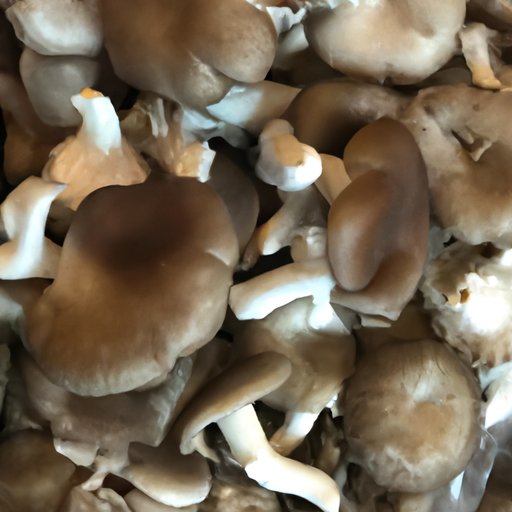
Introduction
Mushrooms are delicious, versatile, and a great source of nutrients. However, while mushrooms can be a fantastic ingredient to use in any meal, identifying the difference between good and bad ones can be difficult. Knowing how to spot bad mushrooms is essential for your health as consuming a bad one can lead to food poisoning, violent symptoms, and even death. To help ensure that you and your family are safe, the following article will provide information on how to tell if mushrooms are bad, including signs, risks, and prevention techniques.
Signs of Spoilage
The first step to identifying bad mushrooms is to learn the signs of spoilage. The most common signs of spoilage in mushrooms are odor, texture and discoloration. Good mushrooms should have a mild, earthy aroma with no sour or foul smell. If you detect a strong or pungent odor, this may be a sign that the mushrooms are bad and should be discarded. Similarly, fresh mushrooms have a firm, slightly moist texture. If the texture is slimy or sticky, you should not eat them, even if they have a good smell. Finally, discolored mushrooms, especially in the cap, can be a sign of spoilage. Be careful of mushrooms that show any signs of browning, mold, or dark spots as these are some examples of discoloration that could indicate bad mushrooms.
Mushroom Storage
To prevent bad mushrooms, proper storage is essential. Mushrooms are very delicate, so they must be stored carefully to prevent bruising or damage. Avoid washing mushrooms before storage as this can create moisture and make them more prone to spoilage. Instead, store the mushrooms in a paper bag or a breathable container. Whatever method you choose, keep mushrooms away from direct sunlight and in a cool, dry place. Excessive heat or moisture can cause mushrooms to spoil quickly, so it’s essential to monitor the environment. In this way, you can extend the shelf-life and ensure that mushrooms stay fresh for longer.
Cooking Techniques
Cooking mushrooms properly is an effective way to help identify any spoilage. Cooking mushrooms not only changes their texture and flavor but also has a significant impact on their safety. Cooking mushrooms safely can kill harmful bacteria, making it easier to visually identify a spoiled mushroom. Make sure to cook mushrooms thoroughly by frying or baking them until they are crispy. Avoid eating raw mushrooms as they can carry harmful pathogens, which can cause food poisoning. Cooking mushrooms can also bring out their unique flavor and texture while further ensuring their safety.
Best Practices
The best way to avoid eating bad mushrooms is to purchase them fresh. Always look for mushrooms with firm stems, dry caps, and no visible blemishes or discoloration. Avoid mushrooms that are slimy, spotted, or have a sour odor. When purchasing mushrooms, choose those that are not pre-sliced or diced as these will spoil more quickly. Fresh mushrooms will stay safe for longer, given proper storage, and an estimated shelf life of up to 7 days.
The Risk of Consumption
The decision to consume a bad mushroom could lead to food poisoning and even serious health complications. Headaches, vomiting, nausea, and diarrhea are some of the adverse symptoms that can occur after consuming bad mushrooms. Food poisoning can result in dehydration, which can be dangerous for elderly people, pregnant women, and children. It’s crucial to remember that not all poisonous mushrooms show visible signs of spoilage, which is why it is important to be cautious.
Testing Mushrooms
Testing mushrooms properly is the final safeguard before consuming them. There are a few precautions you can take to check for spoilage before cooking or eating mushrooms. You must look for any changes in color, texture, or the appearance of mold or slime on them. To distinguish good mushrooms from bad, you can perform a smell test. If the mushroom smells sour or rancid, do not use them.
Another method for testing mushrooms is to use a mushroom testing kit or seek the guidance of an experienced mushroom farmer. These kits detect poisonings in wild mushrooms and will either give an okay signal, indicating that the mushroom is safe to eat or a warning signal, indicating that it is poisonous, and you should discard it. Test kits may not be 100% accurate, but when used correctly, they offer an excellent additional security test when picking wild mushrooms.
Safe Disposal
Safely disposing of bad mushrooms is crucial to prevent additional contamination or injury. When you discard them, give them a quick rinse with hot water or seal them in a plastic bag and then throw them away in the trash. Additionally, if you suspect someone has consumed a poisonous mushroom, take them to an emergency center immediately. Be sure to bring along any remnants of the mushroom, which may help doctors decide the best treatment.
Conclusion
As illustrated throughout the article, recognizing and preventing spoilage in mushrooms is a straightforward process that primarily involves learning how to spot the signs of spoilage, practicing proper storage techniques, cooking methods, and knowing how to test mushrooms to ensure they are safe to eat. Taking these steps will go a long way in ensuring that you and your family are safe when consuming mushrooms.
So, the next time you are shopping for mushrooms, remember to look for those that are fresh, firm, and fragrant. Store them correctly, cook them thoroughly, test them safely, and discard them safely if they’re spoiled. With these tips in mind, you can enjoy your next mushroom dish with peace of mind.




